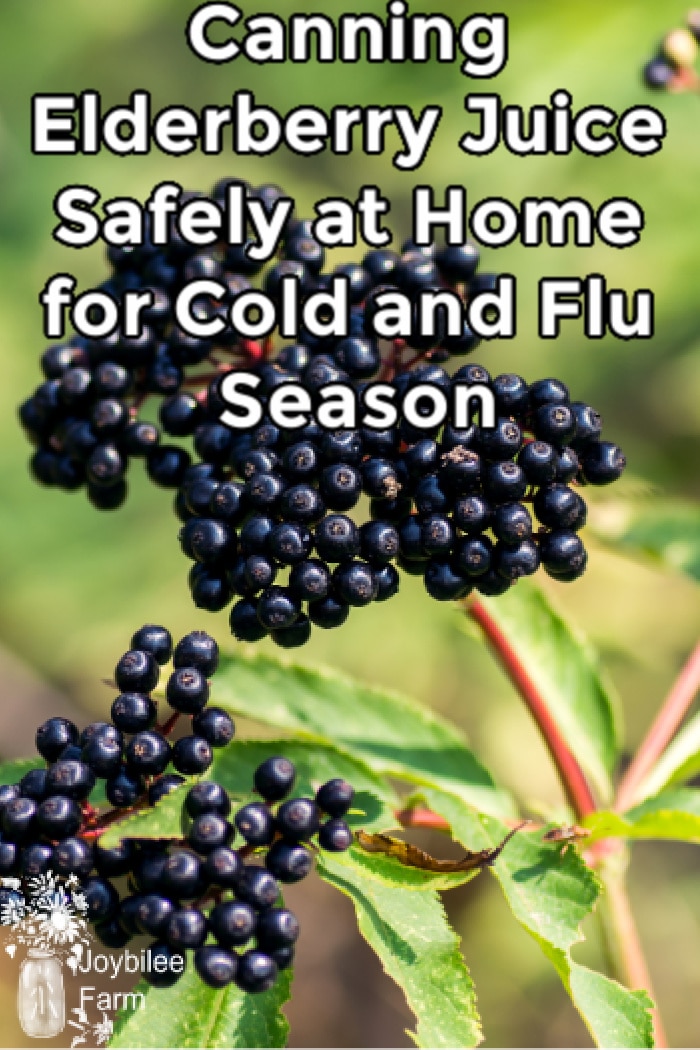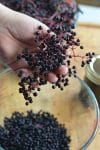
Soil pH affects the pH of the fruit

Glass of fresh elderberry syrup with cinnamon stick, brown sugar, star anise and elderberries on a wooden kitchen counter
Canning Elderberry Juice Safely at Home
Print
Canning Elderberry Juice at Home Safely
- Yield: 4 pints 1x
Description
Some elderberry varieties have a higher pH than the 4.6 recommended for safe water bath canning at home. Increasing the acidity of elderberry juice can improve the safety of home canned elderberry juice, jam, and jelly to prevent the growth of botulism.
Ingredients
- 8 cups elderberry juice
- 4 tablespoons lemon juice, bottled or 1 teaspoon citric acid
- sugar to taste (optional) (Honey may be added before serving)
Instructions
- Extract elderberry juice from fresh or frozen elderberries. Add 1 tablespoon lemon juice or 1/4 teaspoon citric acid per pint jar. Pour hot juice into jars over acid additive.
- Heat canning jar lids in a saucepan of simmering water to soften seal or treat them according to the manufacturers directions. Clean jar rims with clean towel to remove residual juice. Remove from pan, and place on jar rims of pint jars. Complete seal by screwing on the canning jar rings.
- Place in water bath canner. Fill canner with hot water to cover jars by 2 inches. Bring to a gentle rolling boil over medium heat. Boil for 10 minutes. Turn off heat. Let jars settle for 5 minutes before removing from the canner.
- Remove jars using a jar lifter, and place on a clean towel on the kitchen counter. Allow to cool naturally. This will complete the seals.
- Seal is completed when the top doesn’t give when pressed with your finger.
- When jars have cooled completely and seals have completed, remove the rings and wash the jars. Label and date the jars before storing in a cool, dry place.
- You can use this juice to make elderberry syrup, elderberry jellies, or other elderberry dishes.
Per pint:
- add 1 tablespoon of bottled lemon juice or
- 1/4 teaspoon of citric acid or
- 2 tablespoons cider vinegar



While cyanide evaporates at 26°C, amygdalin evaporates at 226°C, and releases cyanide upon digestion. Know your dosages.
I believe pressure canning should be safe. But no reason to go up to 15psi. Treat them like you would tomatoes. Extension hasn’t had any new funding since 2015 (They are university professors that teach full time and do extension part time.) They haven’t had funding to test this, its just thrown out there to discourage the use of elderberries during a pandemic. Elderberries work. Period.
I’m keen to get into canning and I’ve bought a Pressure canner. Since that process sterilises the juice, and the jars, so they don’t need special treatment, AND you can go the extra and add the acid too, I fail to see why it would grow botulism if the procedures are followed properly.
I appreciate all the extensions have done to work through various recipes and publish them for safe canning, and if I’m going to can something they’ve covered then I use their method. But just because they haven’t yet got round to testing pressure canned elderberries or the juice even, doesn’t mean it isn’t safe. It means they’ve not found out yet. False dichotomy, isn’t it?
I have learned though that making your own adaptations can be fatal if you include things like thickeners or the wrong air gap or whatever, but I don’t think elderberry juice has any of the typical pitfalls in sight, so you? Heat is going to get right through it alright. As ever, I may be wrong so please be responsible for your own research and decisions, dear reader!
I do have a question though – does heat destroy the goodness in the juice, especially if I go up to 15psi? BUt let’s say 10psi. It surely will dismantle any vitamin c, I should think, but what about the anti oxidants and other wonders you describe?
Thank you
You can drink it freely like food. BUT if you were using it for a cold or flu, I’d probably use a tablespoon 4 times a day.
Thank you so much for this recipe for the elderberry juice- how much would you recommend drinking, similar to the elderberry syrup dosage? Thank you!